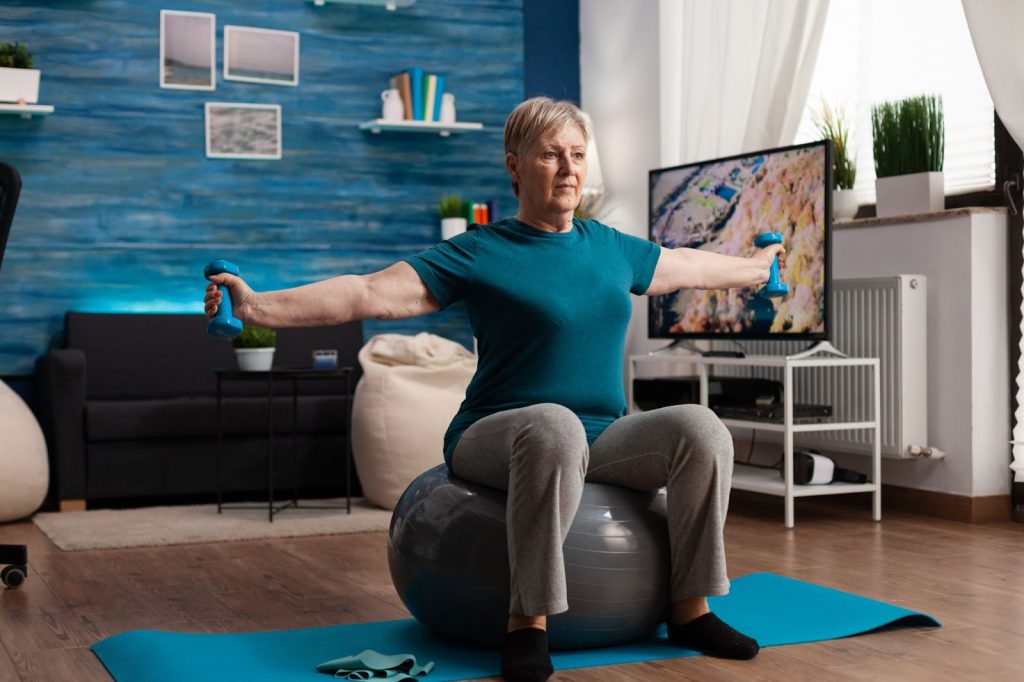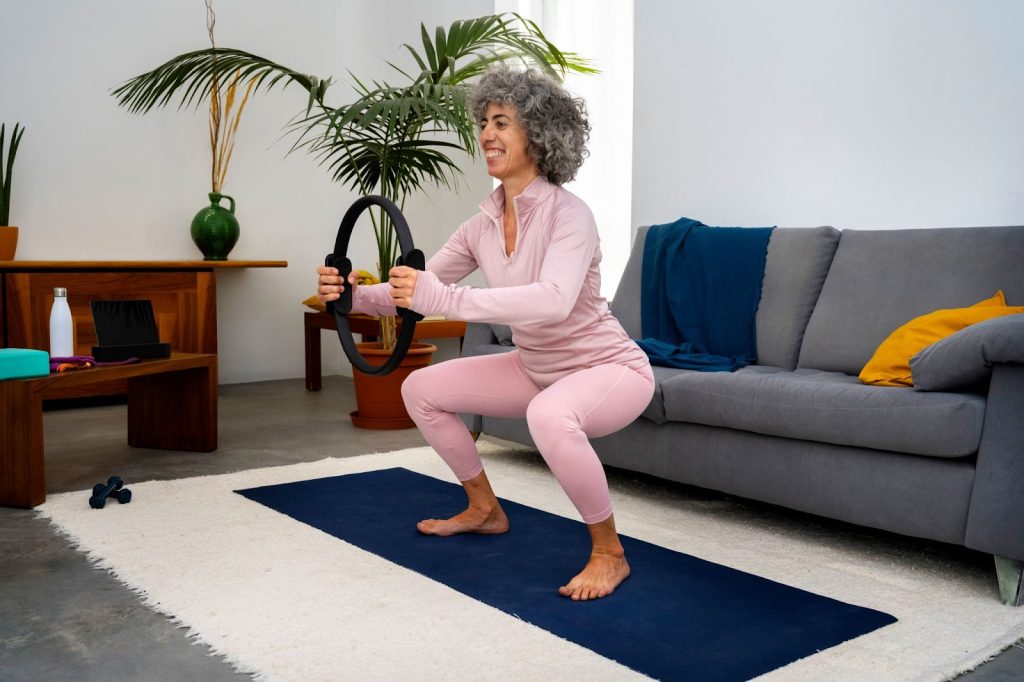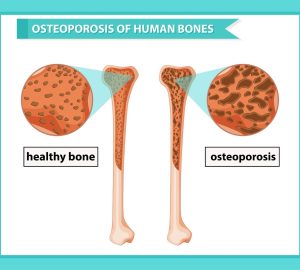Introduction
Maintaining an active lifestyle is crucial for seniors to stay healthy and independent. Senior-friendly home exercises offer a convenient way for older adults to improve their strength, flexibility, and overall well-being. In this comprehensive guide, we’ll explore a variety of exercises tailored specifically for seniors. Whether you’re a senior looking to stay fit or a caregiver assisting a loved one, these exercises can help enhance mobility and vitality.
Why Exercise Matters for Seniors
As we age, our bodies undergo various changes, including a gradual decline in muscle mass, bone density, and flexibility. Physical activity plays a vital role in mitigating these age-related declines and enhancing overall well-being. Here’s why senior-friendly home exercises are so important:
- Improved Mobility and Independence: One of the primary benefits of regular exercise for seniors is improved mobility. It helps maintain joint flexibility and muscle strength, enabling seniors to perform daily tasks with ease and reducing the risk of falls.
- Enhanced Cardiovascular Health: Heart health is a significant concern for seniors. Engaging in cardiovascular exercises helps strengthen the heart and lower the risk of heart disease, which remains a leading cause of death among older adults.
- Management of Chronic Conditions: Many seniors deal with chronic conditions like arthritis, diabetes, or osteoporosis. Tailored exercises can help manage these conditions by reducing pain, improving circulation, and enhancing overall health.
- Mood Enhancement: Exercise has a positive impact on mental health as well. It releases endorphins, the body’s natural mood elevators, which can help combat depression and anxiety often experienced by seniors.
Getting Started
Before beginning any exercise program, especially if you have underlying health conditions, it’s essential to consult with your healthcare provider. They can provide personalized guidance and ensure your safety.
When you’re ready to start your exercise routine, keep the following tips in mind:
- Begin slowly, and gradually increase the intensity of your exercises.
- Listen to your body, and if you experience pain or discomfort, stop the exercise immediately.
- Stay hydrated throughout your workout.
- Incorporate a warm-up and cool-down into your routine to prevent injury.
Senior-Friendly Exercises
1. Seated Marching
- Description: Sit on a sturdy chair with your feet flat on the floor. Lift one knee as high as you comfortably can and then lower it. Alternate legs, mimicking a marching motion.
- Benefits: Improves leg strength and balance.
2. Wall Push-Ups
- Description: Stand an arm’s length away from a wall, place your hands flat against it at shoulder height, and push your body forward and back.
- Benefits: Strengthens the chest and arm muscles.
3. Chair Squats
- Description: Stand in front of a sturdy chair with your feet hip-width apart. Lower your body as if you’re about to sit down and then return to a standing position.
- Benefits: Builds lower body strength and mobility.
4. Neck Tilts
- Description: Sit or stand with your back straight. Gently tilt your head to one side, bringing your ear towards your shoulder. Hold for a few seconds and repeat on the other side.
- Benefits: Relieves neck tension and improves neck flexibility.
5. Leg Raises
- Description: Sit on the edge of a chair with your feet flat on the floor. Lift one leg straight out in front of you and hold for a few seconds before lowering it. Repeat with the other leg.
- Benefits: Strengthens the core and leg muscles.
3. Chair Yoga
- Description: Practice gentle yoga poses using a sturdy chair for support. This promotes flexibility and relaxation.
- Benefits: Enhances flexibility, reduces stress, and improves overall well-being.
4. Resistance Band Exercises
- Description: Use resistance bands to perform exercises that target various muscle groups, such as bicep curls, leg lifts, and chest presses.
- Benefits: Builds muscle strength without the need for heavy weights.
5. Tai Chi
- Description: Try Tai Chi, a low-impact, slow-motion exercise that focuses on balance and flexibility. There are many instructional videos available online.
- Benefits: Improves balance, reduces stress, and enhances mental clarity.

The Challenge: Maintaining Consistency
Common Barriers to Consistency
While the benefits of senior-friendly exercises are clear, many seniors struggle with consistency due to common barriers like lack of motivation, time constraints, or physical discomfort. Addressing these barriers is crucial to establishing a sustainable exercise routine.
Strategies for Overcoming Barriers
Overcoming consistency challenges involves setting realistic goals, finding enjoyable activities, and seeking support from friends or family. Breaking the routine into manageable sessions and celebrating small achievements can make a big difference.
Tailoring Exercises to Individual Needs
Low-Impact Options
Not all seniors have the same physical abilities, so it’s vital to choose exercises that suit individual needs. Low-impact activities like water aerobics or chair yoga are excellent choices for those with joint issues or limited mobility.
Variety is Key
To maintain interest and enthusiasm, seniors should incorporate a variety of exercises into their routine. This not only keeps things exciting but also ensures that different muscle groups are engaged.

Building a Routine
Setting Realistic Goals
Establishing a routine starts with setting achievable goals. Seniors should define what they want to accomplish and create a plan that aligns with their objectives. Start slowly and gradually increase the intensity as fitness levels improve.
Creating a Weekly Exercise Plan
A well-structured weekly exercise plan helps seniors stay organized and committed. It should include a mix of cardiovascular, strength, and flexibility exercises, spreading them out across the week for optimal results.
You Like Might Also Read:
- Choosing the Right Medical Alert System for Seniors
- The Healing Power of Music: A Comprehensive Guide to Music Therapy for Seniors
- Step by Step Guide on How to Use FaceTime for Seniors
Staying Motivated
Celebrating Small Wins
Staying motivated can be challenging, but celebrating small wins along the way can provide a boost. Recognizing progress, no matter how minor, can be incredibly motivating.
Seeking Social Support
Exercising with friends or joining senior fitness classes can provide the social support and accountability needed to maintain consistency. It turns exercise into a social and enjoyable activity.
Conclusion
Incorporating senior-friendly home exercises into your daily routine can significantly improve your quality of life as you age. These exercises cater to the unique needs of seniors, enhancing mobility, cardiovascular health, and overall well-being.
Remember, age should never be a deterrent to staying active and healthy. Whether you’re a senior looking to maintain your independence or a caregiver assisting a loved one, these exercises provide a valuable resource for a more fulfilling, active, and enjoyable life.
Frequently Asked Questions (FAQs)
Can these exercises be adapted for seniors with limited mobility?
Yes, many exercises can be modified to suit various levels of mobility and strength. Always consult with a professional for personalized guidance.
What are some low-impact senior-friendly exercises?
Examples include walking, swimming, chair yoga, and water aerobics.
How can seniors stay motivated to exercise consistently?
Celebrating small achievements, finding enjoyable activities, and exercising with friends or in classes can help maintain motivation.
Is stretching important for seniors?
Yes, stretching helps maintain flexibility and reduces the risk of injury. Incorporate gentle stretching into your routine.
What should I do if I experience pain during exercise?
If you experience pain, stop the exercise immediately. Consult your doctor and consider working with a physical therapist for guidance.
Are there any age restrictions for starting these exercises?
It’s never too late to start exercising. Seniors of all ages can benefit from these exercises with the appropriate modifications.









3 Comments